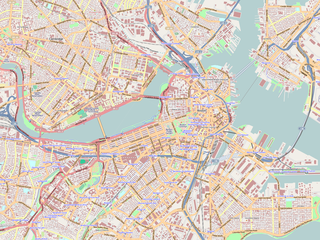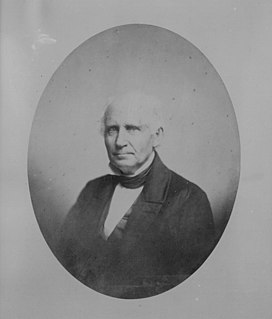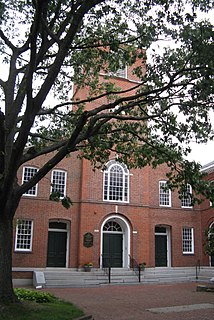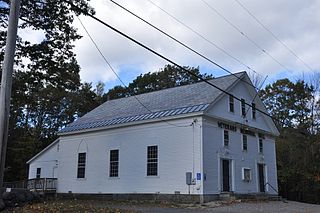
Woonsocket, is a city in Providence County, Rhode Island, United States. The population was 41,186 at the 2010 census, making it the sixth largest city in the state. Being Rhode Island’s northernmost city, Woonsocket lies directly south of the Massachusetts state line and constitutes part of both the Providence metropolitan area and the larger Greater Boston Combined Statistical Area.

Hosea Ballou D.D. was an American Universalist clergyman and theological writer.

The Universalist Church of America (UCA) was a Christian Universalist religious denomination in the United States. Known from 1866 as the Universalist General Convention, the name was changed to the Universalist Church of America in 1942. In 1961, it consolidated with the American Unitarian Association to form the Unitarian Universalist Association.
The Universalist Church of West Hartford is a Unitarian Universalist congregation in West Hartford, Connecticut.

The Arlington Street Church is a Unitarian Universalist church across from the Public Garden in Boston, Massachusetts. Because of its geographic prominence and the notable ministers who have served the congregation, the church is considered to be among the most historically important in American Unitarianism and Unitarian Universalism. Completed in 1861, it was designed by Arthur Gilman and Gridley James Fox Bryant to resemble James Gibbs' St. Martin-in-the-Fields in London. The main sanctuary space has 16 large-scale stained-glass windows installed by Tiffany Studios from 1899 to 1929.

Hosea Ballou II was an American Universalist minister and the first president of Tufts University from 1853 to 1861. Ballou was named after his uncle and went by the name "Hosea Ballou 2d. " Publishers, friends, editors, Tufts University staff, and others generally followed this example. The title of this article reflects the more recent generational suffix usage of the Roman numeral II for those named for an uncle. Ballou used the ordinal number suffix "2d" rather than "2nd."

As of 2007 there are five church buildings in the Sycamore Historic District, located in Sycamore, Illinois, United States which are listed as contributing properties to the district. The Sycamore Historic District was added to the U.S. National Register of Historic Places on May 2, 1978. When it was nominated to join the National Register there were seven church buildings within the district. One of those included is a residential structure that was utilized as a church when it was first constructed; the Arthur Stark House was once home to the Sycamore Universalist Church congregation. In the time since its listing, two churches have been destroyed or demolished. The Evangelical Church of St. John was destroyed by fire in 2004 and the United Methodist Church in Sycamore is no longer extant, replaced by a modern office building.

Saint Clement Eucharistic Shrine is a historic Roman Catholic shrine located on Boylston Street in Back Bay, Boston, Massachusetts. It is dedicated to the adoration of the Eucharist. Saint Clement Shrine is a church of the Archdiocese of Boston, and is host to the Oblates of the Virgin Mary.

St. Joseph Church is parish of the Roman Catholic Church in Cumberland, Rhode Island within the Diocese of Providence. It is known for its historic campus at 1303 Mendon Road, which includes a Gothic Revival style church along with two late 19th-century, clapboard-sheathed, wood-frame structures on the east side of Mendon Road. The church and its accompanying buildings were added to the National Register of Historic Places in 1982 as St. Joseph's Church Complex.

The St. Charles Borromeo Church is a former Roman Catholic parish church in Woonsocket, Rhode Island, located on North Main Street. The parish of St. Charles was canonically suppressed January 12, 2020 and the congregation merged with that of the Church of All Saints, another parish of the Diocese of Providence, although the church remains open as an alternative worship space.

The First Universalist Church is a historic church at 250 Washington Street in Providence, Rhode Island.

The First Universalist Church is a historic church building on the corner of Pleasant, Elm, and Spring Streets in Auburn, Maine. It was built in 1876 to a design by John Stevens of Boston, Massachusetts, and has been a significant landmark in the city since its construction. It is a fine local example of Gothic Revival architecture executed in brick, and was listed on the National Register of Historic Places in 1979.

The Unitarian Universalist Church of Medford and The Osgood House are a historic Unitarian Universalist church building and parsonage house at 141 and 147 High Street in Medford, Massachusetts.

The First Universalist Society of Salem is a historic Universalist former church building at 211 Bridge Street in Salem, Massachusetts.
The city of Woonsocket in the U.S. state of Rhode Island was established as a union of six mill villages along the Blackstone River. These villages are described in more detail below.

The Universalist Unitarian Church is a historic church on Silver Street and Elm Street in Waterville, Maine in the United States. Built in 1832 for a Universalist congregation founded in 1826, it is a prominent local example of transitional Federal-Gothic Revival architecture. It was listed on the National Register of Historic Places in 1978.

The First Unitarian Church of Marietta is a historic Unitarian Universalist church in the city of Marietta, Ohio, United States. Founded in 1869, it uses a building constructed in 1858 for one of its two predecessor churches; this building's high-quality architecture has led to its designation as a historic site.

The Veterans' Memorial Hall, formerly the First Universalist Society Meeting House, is a historic community building on New Hampshire Route 32 in Richmond, New Hampshire. The 1-1/2 story clapboarded wood-frame building was built in 1837 by members of the local Universalist congregation. Richmond was the birthplace of Hosea Ballou, a theologian influential in the development of Universalism; he left the town before this building was built. As originally built, the meeting house had a small tower and belfry, which were removed in 1892 when the building was acquired by the local Grange. The building has seen only modest external alterations since then; the interior has had most of its religious trappings removed, but is also otherwise little altered.

First Unitarian Church is a historic building located in the downtown area of Iowa City, Iowa, United States. The local Universalist congregation traces its beginnings to 1841. Their building at Iowa Avenue and Dubuque Street was destroyed in a fire in 1868, and they built a larger building at Iowa Avenue and Clinton Street. In 1881 the Universalists merged with the local Unitarian Society. In their arrangement, the Unitarians paid for the minister while the Universalists owned the church building. The University of Iowa bought their building in 1907 and renamed it Unity Hall for use as a student union. The Unitarian-Universalist congregation dedicated this Tudor Revival building for their use on October 24, 1908. The dedication address was given by Rev. Eleanor E. Gordon, who was the secretary of the State Unitarian Conference of Iowa at the time. Because of their growth and costs to update the old building, the congregation voted in 2015 to build a new structure in near-by Coralville. They sold this building to developer Jesse Allen. It has subsequently been used as a winter shelter for the homeless while plans were made to include it in a new commercial-residential development. The former church building was listed on the National Register of Historic Places in 2018.

Theodore Parker Unitarian Universalist Church is a historic church building at 1859 Centre Street in the West Roxbury neighborhood of Boston, Massachusetts. Built in 1900 to a design by West Roxbury native Henry M. Seaver, it is a locally significant example of Normanesque architecture, and is adorned by stained glass windows created by Louis Comfort Tiffany and his firm. The church was listed on the National Register of Historic Places in 2020. The congregation it houses was founded in 1712, and is named for the influential Transcendentalist and abolitionist Theodore Parker, who was the congregation's minister in the 1840s.



















